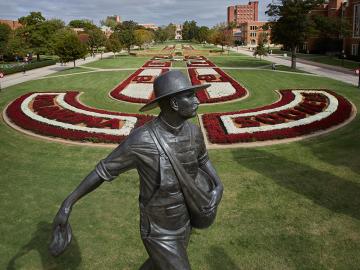Filter News
Area of Research
- (-) Clean Energy (48)
- Advanced Manufacturing (6)
- Biology and Environment (14)
- Building Technologies (1)
- Computational Engineering (2)
- Computer Science (4)
- Electricity and Smart Grid (1)
- Fusion and Fission (7)
- Isotopes (5)
- Materials (11)
- Materials for Computing (14)
- Mathematics (1)
- National Security (4)
- Neutron Science (10)
- Quantum information Science (1)
- Sensors and Controls (1)
- Supercomputing (9)
- Transportation Systems (1)
News Type
News Topics
- 3-D Printing/Advanced Manufacturing (18)
- Artificial Intelligence (1)
- Big Data (2)
- Bioenergy (2)
- Biology (4)
- Biotechnology (1)
- Buildings (7)
- Chemical Sciences (1)
- Clean Water (1)
- Climate Change (3)
- Composites (5)
- Computer Science (3)
- Coronavirus (1)
- Critical Materials (3)
- Decarbonization (2)
- Energy Storage (13)
- Environment (6)
- Grid (6)
- High-Performance Computing (2)
- Materials (15)
- Materials Science (5)
- Mathematics (1)
- Microscopy (1)
- Nanotechnology (1)
- Net Zero (1)
- Polymers (3)
- Space Exploration (1)
- Statistics (1)
- Sustainable Energy (20)
- Transportation (10)
Media Contacts

ORNL and Tuskegee University have formed a partnership to develop new biodegradable materials for use in buildings, transportation and biomedical applications.

Oak Ridge National Laboratory has released the federal government’s new 2022 Fuel Economy Guide. The report provides the latest fuel efficiency stats and money-saving tips for new and used vehicles.

Ten scientists from the Department of Energy’s Oak Ridge National Laboratory are among the world’s most highly cited researchers, according to a bibliometric analysis conducted by the scientific publication analytics firm Clarivate.

Researchers at ORNL designed a novel polymer to bind and strengthen silica sand for binder jet additive manufacturing, a 3D-printing method used by industries for prototyping and part production.

Scientists at the Department of Energy’s Oak Ridge National Laboratory have developed a scalable, low-cost method to improve the joining of materials in solid-state batteries, resolving one of the big challenges in the commercial development of safe, long-lived energy storage systems.

Amy Elliott, a group leader for robotics and intelligent systems at Oak Ridge National Laboratory, has received the 2021 ASTM International Additive Manufacturing Young Professional Award for her early career research contributions

ORNL and the University of Oklahoma, known as OU, recently executed a memorandum of understanding to officially recognize their partnership in pursuing shared research and development goals.

ORNL has named three researchers ORNL Corporate Fellows for their significant career accomplishments and continued leadership in their scientific fields.

Oak Ridge National Laboratory researchers have developed a novel process to manufacture extreme heat resistant carbon-carbon composites. The performance of these materials will be tested in a U.S. Navy rocket that NASA will launch this fall.

Oak Ridge National Laboratory researchers developed and demonstrated algorithm-based controls for a hybrid electric bus that yielded up to 30% energy savings compared with existing controls.




